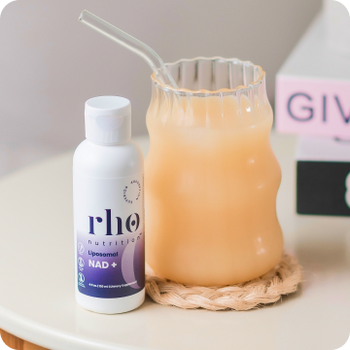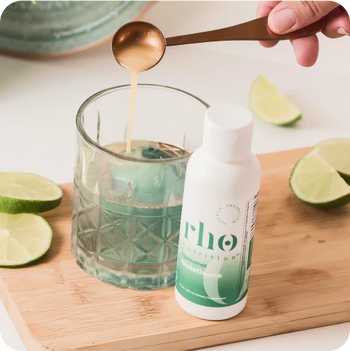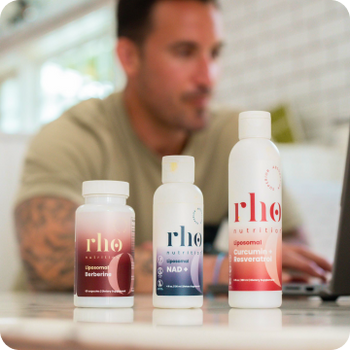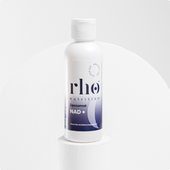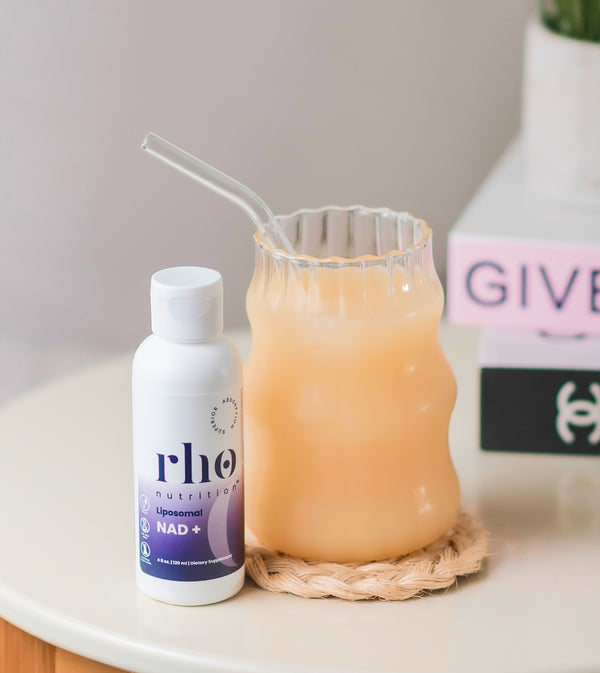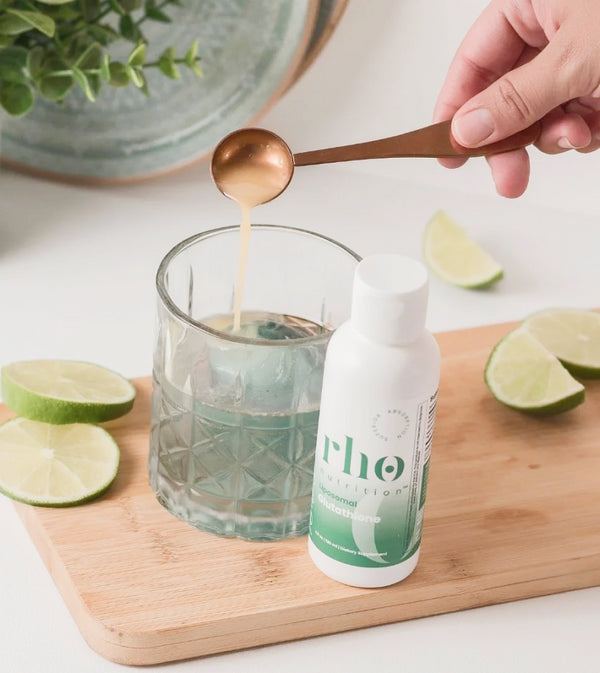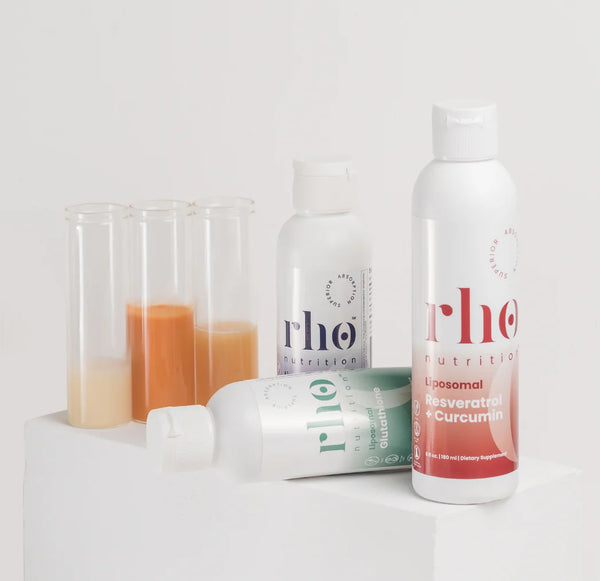FAQs
Categories
What Makes Rho Different
Liposomal delivery is a technique used to help support the absorption and bioavailability of certain nutrients. It involves encapsulating the active ingredient within tiny lipid-based bubbles called liposomes. These liposomes act as protective carriers, helping the nutrient pass through the digestive system and supporting its absorption into the body.
Yes, every Rho product is third-party tested and manufactured in an FDA-registered and GMP-certified facility located in Colorado. We follow a rigorous quality control process to ensure our products meet the highest standards of safety, purity, and potency.
Each production lot undergoes third-party testing for:
- Heavy metals
- Microbial contaminants
- Adulterants
- Active ingredient purity
All testing is conducted under strict GMP guidelines, and every lot is issued a Certificate of Analysis (COA) to verify its quality.
For full transparency, we publish the most recent third-party test results in the product image gallery on each product page of our website.
All of our products are manufactured in an FDA registered and GMP-certified facility located in Colorado. We have a comprehensive quality control process in place to ensure that our products meet the highest standards of quality.
Every single lot that is manufactured is third-party tested for purity, safety, and potency. We test for heavy metals, microbio, adulterants, and active ingredient purity under GMP guidelines. Each manufacturing lot is also assigned a Certificate of Analysis to guarantee its quality. We publish the latest third-party test results in the listing photos of every product page on our website.
The natural flavors are derived from herb and citrus extracts refer to flavoring compounds that are obtained from natural sources, such as herbs like basil, rosemary, or mint, and citrus fruits like oranges, lemons, or limes to enhance or modify the taste profile of our products, making it more palatable to the consumer. These extracts are often achieved through distillation, fermentation, or cold pressing to isolate the specific flavor molecules. Unlike synthetic or artificial flavors, which are formulated in a lab, these natural flavors are directly sourced from plants.
IV NAD therapy delivers a large dose of NAD all at once, which can create a quick spike in levels but that boost is often short-lived and can come with side effects like nausea or a racing heart. Rho’s Liposomal NAD+ is designed for daily use, providing a consistent, highly absorbable dose that supports building up your NAD levels gradually over time. This steady approach is more in line with how your body naturally produces and uses NAD, making it a more sustainable and gentle option for long-term energy, focus, and cellular health without the crash or the needle.
Rho Liquid Liposomal Creatine is different from traditional powder creatine in several ways:
- It’s a 100% soluble pre-dissolved liquid that can conveniently be taken straight or instantly mixed with any drink
- Unlike Creatine powders it has a very pleasant and enjoyable taste
- It uses a Liposomal technology that increases absorption preventing bloating, stomach pains or excess water retention that some experience from creatine powder
- It’s the highest quality Creatine on the market, manufactured in the USA in a GMP-certified and FDA registered facility and trusted by professional athletes
*These statements have not been evaluated by the Food and Drug Administration. This product is not intended to diagnose, treat, cure, or prevent any disease.
Sunflower lecithin is often confused with sunflower oil, but the two are very different. While sunflower oil is simply the pressed oil from sunflower seeds, sunflower lecithin is a special substance extracted from these seeds that contains important nutrients called phospholipids. One key phospholipid it provides is phosphatidylcholine, which is essential for building true liposomes—tiny, protective “bubbles” that can carry nutrients into your cells more effectively. In other words, sunflower lecithin is not the same as the sunflower oil you’d use in cooking. Instead, it’s a natural, safe ingredient that helps create stable, high-quality liposomal supplements to improve the delivery and absorption of vitamins and other nutrients.
How to Use Rho
We’ve created a helpful table that shows the best time to take each of our products and lets you know which ones can be combined safely. It's a great resource to get the most out of your routine!
Check out our 'How To Take Rho Products' Guide HERE

It's completely normal for the effects and timelines of our products to vary among individuals. Some people notice improvements right after starting, while for others, it may take a bit longer, sometimes up to 30-60 days, to see changes.
Many of our customers view Rho as long-term investments in their health. They choose to incorporate them into their daily routines for ongoing well-being and future health support.
You can adjust your Rho intake based on your personal goals and needs. For general daily wellness, we recommend taking it once a day. However, you can safely take Rho up to twice daily for enhanced benefits.
- If you're new to Rho and looking for quicker results, consider a short loading phase during your first week—taking it up to three times daily. This can help accelerate the initial effects and support faster adaptation.
- Remember, everyone’s body is different, and finding the routine that works best for you is key. If you have any questions or would like personalized guidance, feel free to reach out—we’re here to help!
*These statements have not been evaluated by the Food and Drug Administration. These products are not intended to diagnose, treat, cure, or prevent any disease.
Yes, you have a few options for consumption - you can take them directly from a teaspoon individually, or you can mix them all together into a glass of water, juice, shake, tea, or any other beverage you prefer. Many customers choose to mix them for convenience, but do keep in mind that this might alter the taste slightly, if that's important to you we recommend taking them individually.
Is Rho Right for Me?
While we do have many customers that give Rho to their kids we always recommend consulting with your qualified healthcare professional before using any of our products if you are under the age of 18.
If pregnant or nursing we recommend consulting with your qualified healthcare professional before starting a new supplement.
All Rho products are 100% vegan - except for D3K2 and Collagen, which are not. They contain zero calories and are completely free from sugar, dairy, gluten, GMOs, soy, nuts, corn, additives, and artificial coloring.
Rho is also compatible with a wide range of dietary lifestyles, including: Vegetarian, Vegan, Keto, Intermittent Fasting, Gluten-Free, Halal, and Kosher.
You can absolutely travel with your Rho products—no problem at all! While refrigeration enhances taste, it’s not required, so feel free to take them out of the fridge when you're on the move. Just keep in mind the TSA liquid limit for carry-ons is 3.4 oz (100 mL):
- Our 4 fl oz, 6 fl oz, and 15 fl oz bottles exceed that limit and must be packed in checked luggage if you're flying.
- The good news? We now offer some of our most popular products like Curcumin + Resveratrol and Creatine in travel-friendly single-serving sachet packets, which are perfect for on-the-go and TSA-compliant.
- Safe travels, and enjoy your Rho wherever life takes you!
Absolutely! Once your order ships, you'll receive a tracking number via email. You can track your package in real-time using this number on our website or the carrier's tracking page.
Yes, our customer support team is available Monday through Friday, 9 AM to 6 PM EST. You can reach us via email, live chat on our website, or phone. We typically respond to emails within 24 hours.
Most of our products come with a manufacturer's warranty ranging from 6 months to 2 years, depending on the item. Warranty details are listed on each product page and included with your purchase confirmation.
Orders can be cancelled or modified within 2 hours of placement, before they enter our fulfillment process. Contact our customer service team immediately if you need to make changes to your order.
Yes, we offer special pricing for bulk orders (typically 50+ units) and wholesale accounts. Contact our business sales team for custom quotes and volume discounts tailored to your needs.
Absolutely. We use industry-standard SSL encryption to protect your personal and payment information. We never share your data with third parties without your consent and comply with all relevant privacy regulations.
Getting the Most Out of Your Rho
Refrigeration is not required after opening, but we suggest it for the best taste experience.
Unopened, all Rho products have a shelf life of about two years—you can find the “Best By” date printed on the bottom of the bottle.
Once opened, we recommend using the product within 75 days for maximum potency. While they won’t spoil after that time, the effectiveness may gradually decrease.How long do Rho products last?
- Unopened, all Rho products have a shelf life of about two years—you can find the “Best By” date printed on the bottom of the bottle.
- Once opened, we recommend using the product within 75 days for maximum potency. While they won’t spoil after that time, the effectiveness may gradually decrease.
For general daily wellness, we recommend taking it once a day. However, you can safely take Rho up to twice daily for enhanced benefits. We recommend consuming a new product consistently for a couple of months for optimal results. However, if you’re not satisfied for any reason we have a 60-day money back guarantee. Simply email support@rhonutrition.com to let us know and we will happily assist you. You can read the full Refund Policy here.
Stay effortlessly stocked with your favorite Rho products by subscribing to our convenient subscription program. Enjoy 15% off every order plus free shipping, with the flexibility to modify or cancel your subscription anytime—no commitments, just seamless wellness delivered on your schedule.
Orders, Tracking & Delivery
Shipping rates and delivery times vary by destination and will be calculated at checkout. If you have any questions about your country or shipping options, feel free to reach out, we’re here to help!
We ship all orders within 24 hours, Monday through Saturday, from our fulfillment center in New Jersey. Orders placed after 12 PM ET on Saturday or anytime on Sunday will ship out the following Monday.
Domestic (U.S.) orders typically arrive within 3–6 business days. International delivery times vary by destination and may take longer depending on the country and local customs processing.
You’ll receive an email with tracking information as soon as your order ships, so you can follow it every step of the way.
We offer free shipping on all orders over $99 and on all subscription orders. For U.S. orders under $99, a flat rate of $6.49 applies. International shipping rates vary by destination and are calculated at checkout. You'll see your exact shipping cost before you complete your purchase.
We want you to love your Rho experience and if you're not satisfied, we’re here to help. We offer a 60-day money-back guarantee on your first purchase:
You’re eligible for a refund on one product (one bottle) within 60 days of your order.
- For single-item orders, we’ll refund that product.
- For multi-item orders, we’ll refund the highest-priced product.
Alternatively, you can choose a free exchange for any other Rho product you'd like to try - we’ll ship it at no cost to you.
- No returns necessary, just let us know if you’d prefer a refund or an exchange. For full details, you can view our Refund Policy here.
Rho Nutrition offers a flexible subscription program designed for your convenience and savings. Subscription Benefits:
- Enjoy 15% off and free U.S. shipping on every subscription order.
- Easily manage your subscription—pause, cancel, swap products, or adjust delivery dates anytime through our Subscription Portal.
- No long-term commitments; modify or cancel your subscription at any time.
We accept returns for orders that are entirely unused, unopened, undamaged, and returned in their original packaging within 30 days of purchase. We reserve the right to deny any returns that do not meet these criteria. Shipping costs and taxes are non-refundable, and the customer is responsible for return shipping.
Note: Wholesale orders and Amazon orders are not eligible for returns.
How to Return Unopened and Unused Orders:
- Unopened order return requests must be submitted within 30 days of purchase.
- The order must be unopened, unused, undamaged, in the original packaging, and include all original items matching your order confirmation receipt.
- Ensure your return is accompanied by an order packing slip in the box that will be provided by our support team.
- The customer is responsible for their return shipping label
- Returns with opened, damaged, or missing items will not be eligible for a refund.
- Returns initiated more than 30 days after purchase are not eligible for a refund.
- To initiate a return, please contact our Customer Support team at support@rhonutrition.com.
Additional Information:
- Refunds are issued to the original payment method. If the original payment method is unavailable, the refund will be forfeited. Refunds typically take 5-7 business days to process but may vary depending on the bank or credit card company. We cannot process refunds to prepaid debit cards. Orders paid by cashier's check or money order will receive a check via mail sent exclusively to the original billing name and address. No exceptions will be made to prevent fraud.
International Orders:
- Orders shipped outside the USA are not eligible for returns or refunds.
We conduct thorough heat stability testing on both the active ingredients and the integrity of our liposomes to ensure quality. Our products retain their efficacy and potency at temperatures up to 200°F. Because of this, we confidently ship our products worldwide, even during the summer months, without any compromise to their quality.
While refrigeration isn’t required, we recommend chilling the product in the fridge for about 12 hours before use to enhance the taste and overall experience.
NAD+
Liposomal NAD+ delivers pure nicotinamide adenine dinucleotide, a molecule essential for energy and cellular repair, using a high-tech liposomal delivery system. That means better protection through digestion and significantly better absorption at the cellular level.
NAD+ is a vital coenzyme found in every cell of the body. It plays a key role in supporting mitochondrial function and cellular energy production. Maintaining NAD+ levels may help promote cellular resilience, support healthy aging, and contribute to cognitive and metabolic function over time.*
Rho uses a liposomal NAD+ formula instead of precursors like NMN. Our approach is designed to deliver NAD+ directly, without relying on the body to convert precursors.*
Pills often lose potency during digestion. Injections are effective but invasive, costly and time consuming. Rho offers a convenient, liquid solution designed to rival the absorption of IV therapies without the clinic appointment.
Rho’s liposomal NAD+ is an oral supplement designed for convenient, at-home use. While injections and infusions deliver NAD+ directly into the bloodstream, our product uses liposomal delivery to help support absorption when taken by mouth.*
*These statements have not been evaluated by the Food and Drug Administration. This product is not intended to diagnose, treat, cure, or prevent any disease.
Cellular Energy: NAD⁺ is a vital coenzyme involved in cellular metabolism. It supports the conversion of nutrients into energy, helping maintain healthy energy levels.*
DNA Support: NAD⁺ helps support enzymes involved in DNA maintenance and cellular repair, contributing to overall genomic stability and healthy cellular function.*
Mitochondrial Function: NAD⁺ plays a key role in mitochondrial health by supporting efficient energy production at the cellular level, which is essential for overall metabolic function and vitality.*
Brain Support: NAD⁺ supports brain cell metabolism and mitochondrial function, helping to promote healthy cognitive performance and cellular resilience in the brain.*
By age 30, NAD+ levels can decline significantly. Rho’s liposomal NAD+ is designed to support healthy NAD+ levels and cellular function with just one daily teaspoon.
NAD+ (100 mg), Purified water, natural citrus oils, non-GMO sunflower lecithin, monk fruit extract, glycerin, and potassium sorbate.
Each bottle contains 30 servings of 4ml (just under 1 teaspoon)
NAD+ is a coenzyme found in every living cell. It plays a key role in cellular energy production and other biological processes that help support overall health.*
Take 4 ml daily (just under a teaspoon). You can take it straight or mix it into a drink. It has a light lemon taste when taken alone and becomes nearly flavorless when blended.
Yes. Our Liposomal NAD+ is designed to work seamlessly with other Rho formulas. There’s no need to separate doses.
Glutathione
Glutathione is a powerful internal antioxidant, essential for detoxification and cellular defense. Our formula delivers it in a liposomal format, designed to protect the glutathione molecule and enhance absorption so it reaches your cells where it can actually make a difference.
Most glutathione supplements break down before they reach the bloodstream. Ours is delivered through a clinically tested liposomal delivery system. This helps protect the molecule as it travels through digestion and ensures it gets absorbed where it matters most. It’s science-backed support in a daily, drinkable format.
*These statements have not been evaluated by the Food and Drug Administration. This product is not intended to diagnose, treat, cure, or prevent any disease.
With consistent use, you can support your body's natural detox pathways, reduce oxidative stress, brighten skin tone, improve immune function, and enhance recovery after intense activity or stress. Some people report clearer skin, better energy, and a general feeling of “reset” after making it part of their daily routine.
Take 4 ml per day, which is just under one teaspoon. You can take it straight from the bottle or mix it into cold water, juice, or a smoothie. The formula has a lime essence flavor that helps mask glutathione’s natural sulfur scent. Serving it cold makes it even easier to enjoy.
Glutathione can absolutely be taken daily. While it's known for detox support, its antioxidant and immune benefits make it a smart addition to any wellness routine year-round. Think of it as ongoing internal upkeep rather than just a reset button.
Yes. Our Liposomal Glutathione is designed to work seamlessly with other Rho formulas. There’s no need to separate doses.
Some people notice subtle within the first few days. Others experience benefits more gradually. Even if it’s not immediately noticeable, your body is doing the work behind the scenes. This is a product that supports the long game.
Supports Natural Detoxification: Helps support liver detoxification processes by aiding enzyme activity and antioxidant defenses.*
Immune System Support: Supports healthy white blood cell activity and helps maintain a balanced immune response.*
Skin & Collagen Support: Provides antioxidant support that helps maintain healthy skin and supports normal collagen formation and skin elasticity.*
Cellular Antioxidant Defense: Supports cellular health by helping to neutralize free radicals and oxidative stress, which may contribute to long-term wellness.*
Yes. Like all Rho products, it's vegan, sugar-free, calorie-free, and free from soy, dairy, gluten, corn, and artificial ingredients. All of our products are manufactured in an FDA registered and GMP-certified facility located in Colorado. We have a comprehensive quality control process in place to ensure that our products meet the highest standards of quality.
Every single lot that is manufactured is third-party tested for purity, safety, and potency. We test for heavy metals, microbio, adulterants, and active ingredient purity under GMP guidelines. Each manufacturing lot is also assigned a Certificate of Analysis to guarantee its quality. We publish the latest third-party test results in the listing photos of every product page on our website.
Each bottle contains 30 servings. One month of antioxidant-rich, liposomal-powered glutathione.
Collagen Peptides
This is marine-derived hydrolyzed collagen combined with glycosaminoglycans (chondroitin and glucosamine) and hyaluronic acid. It uses liposomal encapsulation to enhance absorption, delivering collagen directly to your cells for maximum impact.
Skin elasticity, hydration & wrinkle reduction: Clinical data show over 20% wrinkle reduction and 38% denser dermis after 90 days
Joint mobility & comfort: Glycosaminoglycans support cartilage health and movement
Stronger hair, nails & connective tissue: Peptide building blocks support overall structural health
*These statements have not been evaluated by the Food and Drug Administration. This product is not intended to diagnose, treat, cure, or prevent any disease
Yes. We use Cartidyss® Type II marine collagen from family-run fisheries in Normandy, France. It’s sustainably harvested as part of local seafood recovery efforts.
Anyone interested in aging well, enhancing joint comfort, or improving skin, hair, nails, and connective tissue. It’s sugar-free, keto-friendly, non-GMO, gluten-free, dairy-free, and soy-free.
Take one teaspoon (4 ml) daily. You can take it straight or mix it into cold water, smoothies, or juices. It has a light vanilla cream taste.
No. While refrigeration helps preserve taste and freshness, it isn’t required. The formula stays stable even at room temperature during travel.
Each 5 fl oz bottle contains 30 servings designed for one month of consistent use.
Absolutely. No need to stagger doses, these products are meant to be part of a holistic wellness routine.
Curcumin + Resveratrol
This is a formulation combining turmeric-derived curcuminoids and resveratrol from Japanese knotweed, encapsulated in clinically tested liposomes. It is a liquid, once‑daily supplement that is up to 10x more absorbable than pills or powders.
Curcumin helps manage inflammation, support joint comfort, and maintain gut balance. Resveratrol enhances cellular health, longevity, and immune resilience. Together, they create a powerful synergy for inflammation, aging, and recovery.
Support for healthy inflammation response to ease joint stiffness
Help with exercise recovery and muscle resilience
Gut support during bouts of inflammation
Cellular protection linked to youthful aging
- Individual outcomes vary, but our customers often report more mobility, comfort, and less afternoon fatigue.
*These statements have not been evaluated by the Food and Drug Administration. This product is not intended to diagnose, treat, cure, or prevent any disease.
Take 6 ml per day (just over a teaspoon). Enjoy it straight or mix it into cold water or juice. It has a bright mango‑orange flavor, free of sugar or artificial sweeteners.
At 6 ml daily, a 5 oz bottle provides 30 servings, supporting one month of enhanced cellular care.
No refrigeration needed. The formula stays stable at room temperature, making it easy to travel with and store.
Absolutely. There’s no need to separate doses. It’s designed to fit into a full‑spectrum health routine.
Magnesium
It’s a highly absorbable form of magnesium designed to actually reach your cells. We use magnesium bisglycinate and gluconate, both known for being gentle on the stomach and effective at supporting relaxation, focus, and recovery. Encapsulated in liposomes, this formula is built for optimal absorption without the digestive side effects common in traditional pills or powders.
Standard magnesium supplements often break down in the gut or cause digestive issues. Our liposomal format protects magnesium through digestion and delivers it across cell membranes.
Magnesium supports over 300 biochemical processes in the body. Clients commonly report deeper relaxation, more restful sleep, reduced muscle tension, improved focus and memory, and emotional balance.
*These statements have not been evaluated by the Food and Drug Administration. This product is not intended to diagnose, treat, cure, or prevent any disease.
Take 6 ml (just over one teaspoon) once daily. You can take it straight or mix it into water, tea, juice, or a smoothie. It has a slight lemon taste. Taking it in the evening enhances relaxation and sleep support.
No. The bisglycinate and gluconate forms are gentle, and our liposomal system further reduces the chance of digestive discomfort.
Not required. While refrigeration can preserve taste, the formula remains stable at room temperature and is travel-friendly.
Anyone wanting better sleep, less stress, enhanced recovery, improved mood, or cognitive clarity. It fits into keto, vegan, fasting, gluten-free, and clean-living protocols.
Each 180 ml bottle contains 30 servings, providing a full month of support.
Absolutely. It complements other Rho formulas. No need to stagger doses, these products are meant to be part of a holistic wellness routine.
Creatine
Rho combines pure creatine monohydrate with a liposomal delivery system. That means no gritty powder, no loading phases, and none of the bloating or stomach discomfort people often get from traditional creatine supplements. Plus, the liquid format tastes smooth and clean. No fuss, no chalkiness.
One tablespoon (15 ml) contains 3,000 mg of creatine monohydrate, an effective dose that supports both performance and recovery without any guesswork.
Unlikely. The liposomes help ensure your cells take in the creatine efficiently, minimizing the water retention or bloating that often comes with traditional versions.
Rho Liposomal Creatine fuels ATP production, the body's main energy source, to support muscle strength and cognitive function.
- Boost strength, power output, and lean muscle mass
- Reduce post-workout muscle damage and speed up recovery
- Support brain health, focus, and mental clarity
*These statements have not been evaluated by the Food and Drug Administration. This product is not intended to diagnose, treat, cure, or prevent any disease.
No. While ideal for athletes and gym-goers, creatine supports cognitive function too. It fuels ATP, your body’s energy currency, in both muscles and brain cells. This makes it a smart addition for anyone focused on maintaining strength, clarity, and vitality over time.
Take one tablespoon (15 ml) per day. You can take it straight or mix it into any cold beverage. To support workouts, aim for it about 30–90 minutes before or after exercise. For cognitive support, mornings work well too. It has a light, creamy vanilla flavor.
The liquid format, combined with liposomal delivery, makes it easy to digest and gentle on the system. It avoids the bloating or discomfort that can come with traditional creatine powders or pills.
No. Like all Rho formulas, it travels well and remains stable at room temperature, so you can easily stash it at home, the gym, or in your bag.
Yes. It complements other Rho formulas. No need to stagger doses; these products are meant to be part of a holistic wellness routine.
Each 15 ml serving tops up one tablespoon per day, giving you 30 servings per bottle for a month of lean muscle and cellular support.
Berberine
Liposomal Berberine is a supplement that combines the potent benefits of berberine with advanced liposomal delivery technology. Berberine is a natural compound known for supporting metabolic health, while liposomal delivery enhances absorption, ensuring that the active ingredients reach your bloodstream effectively.
Supports Healthy Blood Sugar Levels: Berberine has been shown to help maintain normal blood sugar levels, making it beneficial for those looking to manage their glucose metabolism.
Promotes Cardiovascular Health: By supporting healthy cholesterol levels, berberine contributes to overall heart health.
Assists in Weight Management: Berberine may aid in weight management by influencing metabolic pathways and improving insulin sensitivity.
Enhances Digestive Health: Its properties can support gut health, contributing to better digestion and nutrient absorption.
Supports Healthy Aging: The compound's effects on metabolism and cellular health may contribute to healthy aging processes.
The liposomal delivery system encapsulates berberine in lipid layers, protecting it from degradation in the digestive tract and enhancing its absorption into the bloodstream. This advanced technology ensures that a higher percentage of the active ingredient reaches its target, maximizing potential benefits.
Berberine activates an enzyme called AMPK, a master regulator of metabolism. By turning on AMPK berberine enhances glucose uptake in the cells, and reduces glucose production in the liver. This action supports metabolism, sustained energy levels, cardiovascular health, and natural weight management.
An exceptional botanical that promotes heart health, metabolic wellness, balanced glucose levels, and digestive support. Berberine activates an enzyme called AMPK, which is like the body's energy regulator. When AMPK is activated, it helps your body burn fat more efficiently and allows cells to better utilize glucose, contributing to healthy weight management.
*These statements have not been evaluated by the Food and Drug Administration. This product is not intended to diagnose, treat, cure, or prevent any disease.
Individuals seeking to support their metabolic health, maintain healthy blood sugar, manage weight, promote cardiovascular health, women with PCOS, or those looking to promote healthy aging and well-being may find Liposomal Berberine beneficial.
Take 1 capsule daily. While it can be taken anytime with or without food, it is best to take after a meal.
Yes. It complements other Rho formulas. No need to stagger doses, these products are meant to be part of a holistic wellness routine.
Vitamin C
It’s pure vitamin C (1000 mg per teaspoon) encapsulated in liposomes which are tiny fat-based bubbles that protect ascorbic acid through digestion and improve absorption. You get more of the good stuff into your cells for serious results.
Elevated immune support: Boosts white blood cell function, stimulates interferon, and helps regulate inflammation, supporting immune resilience all year long.
Powerful antioxidant defense: Neutralizes free radicals, protects your DNA, proteins, and cells from oxidative stress, and replenishes other antioxidants like glutathione and vitamin E.
Optimized collagen production: Acts as a cofactor for enzymes that stabilize and cross-link collagen fibers—resulting in firmer skin, quicker tissue repair, and stronger connective support.
Detox and vitality support: Promotes healthy recovery from stress by reinforcing your antioxidant systems and supporting metabolic balance.
Because liposomal vitamin C may get you clinical-grade results, support like you’d expect from an IV, but delivered in a simple, drinkable daily dose. Effortless wellness, inside and out.
*These statements have not been evaluated by the Food and Drug Administration. This product is not intended to diagnose, treat, cure, or prevent any disease.
Ideal for anyone who wants:
- A stronger, more responsive immune system.
- Brighter, firmer skin.
- Superior antioxidant protection and recovery.
- A daily boost in vitality and resilience.
*These statements have not been evaluated by the Food and Drug Administration. This product is not intended to diagnose, treat, cure, or prevent any disease.
Each bottle has 30 servings giving you one month of ultra-high absorption immune, skin, and antioxidant support.
Take 5 ml (one teaspoon) daily. You can take it straight, in water, juice, or a smoothie. It has a lightly orange, pleasant and refreshing taste.
Liposomal delivery is what makes this formula different and more effective. It's been shown to be 5 to 10 times more bioavailable than regular vitamin C. The liposomes mimic your own cell membranes, shielding the vitamin C as it moves through digestion and helping it get absorbed directly into your cells, where it can actually go to work. This format also makes it gentler on your stomach, reducing the digestive discomfort that can come with high doses of traditional vitamin C.
Yes. It complements other Rho formulas. No need to stagger doses, these products are meant to be part of a holistic wellness routine.
D3K2
Liposomal D3K2 combines vitamin D3 and vitamin K2 in a liposomal liquid format, designed to enhance absorption so that these nutrients reach your cells more efficiently.
Vitamin D3 is one of the most essential nutrients for immune function, bone strength, and overall health, playing a key role in regulating the immune response and reducing inflammation. It also helps the body absorb calcium, but without Vitamin K2, that calcium can accumulate in arteries instead of bones. K2 works synergistically with D3 by directing calcium to where it’s needed, supporting both bone density and cardiovascular health.
The liposomal form protects D3 and K2 from digestive breakdown and mimics cell membranes, boosting bioavailability so more of each vitamin reaches your bloodstream and works effectively.
In a clinical study, participants taking liposomal D3K2 saw a 73 % increase in blood vitamin D levels after one month, compared to only 16 % with non-liposomal supplements. Those who were initially deficient experienced a whopping 112 % increase.
You take just 2 ml (½ teaspoon) per day, giving you 2,500 IU of vitamin D3 and 200 mcg of vitamin K2. The formula has a refreshing berry flavor and mixes easily with water, juice, or a smoothie.
Absolutely. It’s vegan, sugar-free, calorie-free, and free from soy, dairy, gluten, corn, and artificial ingredients. It’s made in an FDA-registered, GMP-certified facility and undergoes rigorous third-party testing for purity, potency, and safety.
Each 60‑serving bottle provides two months of daily immune, bone, and cardiovascular support at the suggested dose.
It’s ideal for anyone looking to support immune function, ensure healthy calcium absorption, maintain strong bones, support heart health, or optimize vitamin D status, especially during fall, winter, or anytime exposure to sunlight is limited.
CoQ10
Liposomal CoQ10 is a highly absorbable form of Coenzyme Q10, delivered using liposomes. These tiny fat-based structures protect CoQ10 through digestion and help it reach your cells more effectively. CoQ10 is essential for producing cellular energy and protecting against oxidative stress, but it's difficult to absorb in standard forms. The liposomal delivery system helps your body actually utilize the CoQ10 you take, making it more effective.
Heart & Cardiovascular Health
- CoQ10 supports the heart’s energy needs, supporting blood vessels, and optimal heart rhythm, providing foundational support for long-term cardiovascular wellness.*
Cellular Energy Production
- Optimizes mitochondrial function to boost ATP production, the body’s primary energy source, enabling sustained vitality and improved endurance for daily activities and workouts.*
Antioxidant Defense
- Provides robust protection against free radicals, reducing oxidative stress that can accelerate cellular aging, while synergizing with other antioxidants like vitamin E and glutathione.*
Healthy aging
- Combats the natural decline of CoQ10 levels associated with aging, helping to sustain energy, cardiovascular support, cognitive function, and overall vitality over time.*
*These statements have not been evaluated by the Food and Drug Administration. This product is not intended to diagnose, treat, cure, or prevent any disease.
Liposomal encapsulation shields CoQ10 from breakdown during digestion and mimics the structure of cell membranes, dramatically improving bioavailability so more of the nutrient reaches your cells intact.
Take 6 ml (just over one teaspoon), in the evening preferably close to bedtime either with or without food. You can mix it into water, juice, a smoothie or just drink it straight. It has a tangy orange flavor.
Absolutely. It’s vegan, sugar‑free, calorie‑free, and free from soy, dairy, gluten, corn, and artificial ingredients. It’s manufactured in an FDA‑registered, GMP‑certified facility, and every batch undergoes third‑party testing for purity, potency, and safety.
This formula is ideal for anyone seeking to elevate cellular energy, support cardiovascular health, boost antioxidant defenses, or proactively age with vitality.
Yes. Liposomal CoQ10 complements other Rho products like NAD+ and Glutathione beautifully. However, it’s always best to check with your healthcare provider before adding CoQ10 to your regimen.
Each bottle contains a one-month supply, supporting daily energy, cardiovascular, and antioxidant health.
Quercetin
Liposomal Quercetin combines quercetin, a potent polyphenol flavonoid, with advanced liposomal delivery technology to protect it through digestion and boost absorption so it reaches your cells effectively. It helps stabilize histamine levels, reduce inflammation, support immune defense and is a powerful antioxidant.
Quercetin supports natural allergy relief by stabilizing histamine levels and reducing inflammation. It also enhances immune defense and offers powerful antioxidant protection, helping defend against oxidative stress and support long-term cellular resilience.
Encapsulating quercetin in liposomes shields it from digestive breakdown, making it up to 10× more bioavailable than standard forms and ensuring more of the active compound reaches your bloodstream.
Take one 6 ml serving (~1 teaspoon) daily. You can take it straight or mix it into cold water, juice, a smoothie, or shake. The natural orange mango flavor makes it easy to enjoy.
Absolutely. It’s vegan, sugar‑free, keto-friendly, non-GMO, and free from soy, dairy, gluten, fillers, binders, or artificial colors. All batches are manufactured in a cGMP-certified facility in the USA and undergo third-party testing for purity, potency, and safety.
Each bottle provides 30 servings, one month of potent allergy, immune, and antioxidant support.
It’s designed for anyone seeking natural relief from seasonal allergies, stronger immune function, reduced inflammation, and long-term protection against cellular aging.
Yes. It complements other Rho formulas. No need to stagger doses, these products are meant to be part of a holistic wellness routine.
Sleep Formula
Liposomal Sleep Formula is a fast‑acting liquid blend of 3 mg melatonin, GABA, and glutathione delivered in liposomes to enhance absorption, promote deep rest, reduce nighttime awakenings, and minimize grogginess upon waking.
This formula calms your mind and nervous system, helping to ease stress and support relaxation; it reduces the time it takes to fall asleep and decreases nighttime wake‑ups; and supports cellular repair overnight, so you wake up feeling refreshed, clear‑headed, and fully restored.
*These statements have not been evaluated by the Food and Drug Administration. This product is not intended to diagnose, treat, cure, or prevent any disease.
Thanks to its liposomal delivery, the formula is absorbed rapidly and efficiently which supports quicker onset of sleep without the “hangover” feeling often associated with heavier sleep aids.
Take 1 ml, which is 6 pumps, about 45 minutes before bedtime without food. It has a pleasant natural flavor and can be taken straight or mixed into water or a nighttime beverage.
Yes, this vegan-friendly, sugar-free formula is made in an FDA-registered, GMP-certified facility. It's third-party tested for purity and potency, and backed by a 60-day money-back guarantee.
Each bottle contains 30 servings, giving you a full month of nightly support.
It’s ideal for anyone seeking natural, clean support for falling asleep faster, staying asleep longer, reducing nighttime awakenings, and waking up refreshed without heavy sedatives or grogginess.
Absolutely. Liposomal Sleep Formula is formulated to complement other Rho products seamlessly. Always check with your healthcare provider if you’re taking medications or managing health conditions.
B12
Liposomal Methyl B12 is a high-absorption liquid supplement delivering 1000 mcg of methylcobalamin, the active form of vitamin B12, in a liposomal delivery system. This advanced formula ensures superior bioavailability, allowing for direct cellular uptake and supporting optimal performance.
This formula supports sustained energy levels, supports nerve health, sharpens cognitive function, healthy metabolism, elevates mood, and promotes overall vitality. Vitamin B12 plays a crucial role in supporting energy production, cognitive health, and mood regulation. Deficiencies may lead to fatigue, cognitive decline, and mood imbalances.
Liposomal encapsulation protects the vitamin through digestion and enhances absorption, making it up to 10 times more bioavailable than standard forms. This ensures more of the active nutrient reaches your cells intact, maximizing effectiveness.
Take 1/2 ml (approximately 3 pumps) daily. You can take it straight or mix it into water, juice, or a smoothie. The formula has a natural berry fusion flavor, making it easy to enjoy.
Yes. It’s vegan, sugar-free, calorie-free, and free from soy, dairy, gluten, corn, and artificial ingredients. Manufactured in an FDA-registered, GMP-certified facility, each batch undergoes third-party testing for purity, potency, and safety.
Ideal for anyone seeking to elevate energy levels, support cognitive function, and promote overall vitality, especially those with dietary restrictions or absorption challenges.
Each bottle contains 60 servings, providing a two-month supply.
TMG
TMG (trimethylglycine), also known as betaine, is a naturally occurring compound found in foods such as beets, spinach, and whole grains. In the body, it acts as a methyl donor that helps recycle homocysteine back to methionine, supporting SAMe production and overall methylation activity.* TMG also functions as a cellular osmolyte, helping cells maintain normal fluid balance and resilience under metabolic and environmental stress.*
Liposomal TMG+ encapsulates TMG inside tiny phospholipid spheres that resemble cell membranes.* This delivery system is designed to help protect TMG through the digestive tract and support efficient absorption and cellular uptake, so more of what you take is available for use by your cells compared to standard non-liposomal forms.*
Liposomal TMG+ is designed for adults looking to support healthy homocysteine metabolism, methylation pathways, and liver function.* It can also be a useful addition for individuals focused on performance, recovery, and maintaining a healthy body composition, especially when combined with a nutrient-dense diet, regular exercise, and other foundational lifestyle habits.*
TMG helps support healthy homocysteine metabolism, and homocysteine is one factor involved in cardiovascular health.* While TMG is not intended to diagnose, treat, cure, or prevent cardiovascular disease, supporting normal homocysteine metabolism is one way to help maintain overall cardiovascular function as part of a comprehensive lifestyle approach.*
Take 6 mL (just over one teaspoon) per day, or as recommended by your healthcare practitioner.* You may take it directly by mouth or mixed in a small amount of water or your favorite beverage. Each bottle contains 30 servings and will last 30 days when used as directed.*
Liposomal TMG+ can be taken at any time of day. Many people prefer taking it in the morning, with or without food, to support daytime methylation and energy pathways.* Others choose to split the serving between morning and early afternoon. The most important factor is consistent daily use as part of your routine.*
If you take prescription medications or have a medical condition, including cardiovascular, liver, or kidney conditions, talk with your healthcare provider before using Liposomal TMG+.* TMG is often used alongside B vitamins, creatine, and other metabolic support nutrients, but your clinician can help you determine the best combination for your individual needs.*
Yes. Liposomal TMG is designed to complement other Rho formulas, NAD+, glutathione, magnesium, curcumin + resveratrol, B12, and performance-support products.* If you are using multiple supplements or have a medical condition, consult your healthcare professional to personalize your protocol.*
TMG is generally well tolerated. Some individuals may notice mild digestive changes when starting TMG-containing supplements, especially at higher intakes.* If you are sensitive, consider starting with a smaller amount and gradually increasing to the full serving as tolerated. As always, speak with your clinician if you have specific concerns or if you experience persistent discomfort.*
Yes. All Rho products are manufactured in a non-GMO, gluten-free, soy-free, dairy-free, and nut-free facility. Every batch undergoes third-party testing for identity, purity, potency, and contaminants. All Rho products are produced in a cGMP-certified, FDA-registered facility with full quality documentation.
No questions found matching your search. Try different keywords or browse the categories above.
Your Health Optimization Journey Begins Here
Be the first to know about the newest product drops, special offers, free E-books, and giveaways!
